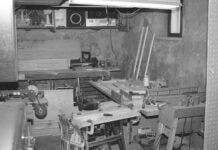 Kits these days are pretty good, as are their instructions. When they tell you to use an AD4-7 rivet in a particular hole, it’s probably the correct size and it comes in a kit in a bag of rivets that same size. You don’t have to do a lot of thinking although that is a trap you don’t want to fall into, because occasionally, tolerances will make you want a slightly longer or shorter rivet. Remember—you want a tail 1.5 times the diameter of the rivet sticking out of the hole (one what will be the shop head side) before squeezing. There’s a little tolerance on this, but if you’re short, the head will be under formed, and if long, you’ll probably tip the rivet.
Kits these days are pretty good, as are their instructions. When they tell you to use an AD4-7 rivet in a particular hole, it’s probably the correct size and it comes in a kit in a bag of rivets that same size. You don’t have to do a lot of thinking although that is a trap you don’t want to fall into, because occasionally, tolerances will make you want a slightly longer or shorter rivet. Remember—you want a tail 1.5 times the diameter of the rivet sticking out of the hole (one what will be the shop head side) before squeezing. There’s a little tolerance on this, but if you’re short, the head will be under formed, and if long, you’ll probably tip the rivet.
The kit we’re working on now, the F1 Rocket, is over twenty years old however, so it’s not quite as complete and the instructions hadn’t reached the IKEA stage when produced. That’s OK, it’s still miles ahead of some kits produced in the 70’s! Today I was riveting together the rear spar for the horizontal stabilizer, and picking my rivets carefully, as the lengths aren’t called out, and the thicknesses change from tip to root several times. The kit had bags of rivets in various lengths, but in some cases, I needed lengths in between so out came my good old rivet cutter.
If you’re building a metal airplane, and don’t have one—get one! They are inexpensive, easy to figure out… and if you have one, you’ll be more likely to use proper rivet lengths than if you don’t and have to settle on the rivets you have in the bag. Today I was cutting AD5-9 rivets into -8 lengths—I needed about forty of them, and that took about five or ten minutes. This is, after all, a pretty important piece of structure, and getting it right is important. Set the stack of spacers for the length you want, pop a rivet in the hole, squeeze the handle, pop the cut rivet out and check it. If it’s right, make a batch of them. If not, change the spacers and try again. Yes, your hand will get a workout cutting 5/32” rivets, but we all need exercise.
Cutting rivets is part of building—one of those skills you need to do a good job, so don’t fear the cutter and embrace the task and may all your rivets be perfectly formed.













